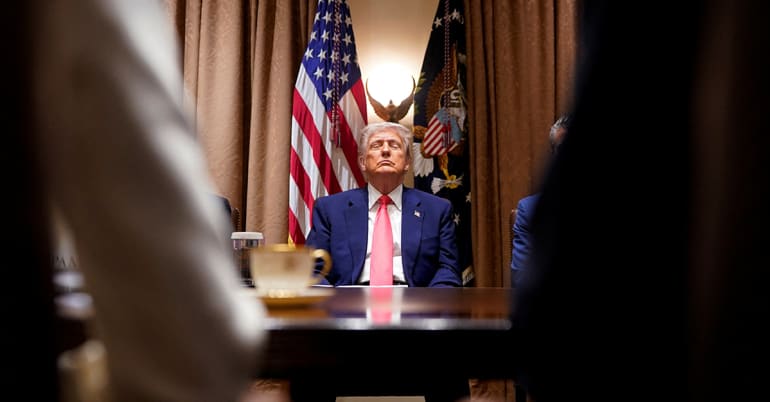One of the most common misconceptions at the start of this year was that the new US administration would act without an economic plan. But there clearly is one, and it is partially defensible, even if it seems unrealistic to many market observers.
President Trump’s plan is simple: reshape American taxation to produce lasting and profound changes. These include closing its enormous trade deficit, reviving its struggling industrial sectors and normalising the role of the US in the global economy.
Implementing this strategy is straightforward: tax imports using a rule that suggests this protection will last, forcing foreign companies to develop US productive capacity. This will stimulate US growth, thereby generating more tax revenue and simultaneously reducing the ‘twin deficits’ of the state budget and trade.
The plan is ambitious. What are its chances of success in 2025 and the remainder of Donald Trump's term? Simply put applies quantitative tools to answer this question.
Read also: Multi-asset: investing in a period of tariff-induced uncertainty
Unpacking the president’s plan
Aiming to overcome a classic economic policy challenge, President Trump wishes to use taxation to create changes in the American economy that he sees as virtuous. These changes are simple and identifiable:
- Reduce corporate tax by 6%, lowering the tax rate from 21% to 15%. (It was previously reduced from 35% to 21% during Donald Trump's first presidency)
- Finance this tax reduction in two ways: through fiscal revenues generated by import tariffs and savings generated by budget cuts recommended by the Department of Government Efficiency (DOGE).
This is clear on paper. To ensure markets react positively and avoid a ‘Liz Truss’ moment, the White House has initially focused on the second part of the project: securing tax revenues and lower state spending before announcing tax cuts. For the plan to work, any improvement in the US fiscal position caused by DOGE and tariffs must correspond to the shortfall that will come from lower taxes on corporate profits.
With these working hypotheses, we estimate US fiscal revenues will be about USD 340 billion in 2025, assuming US growth remains insensitive to White House policy and rises by 5% in 2025. If this is not the case and nominal growth settles at zero, then these revenues would decline by about USD 10 bn. The order of magnitude is preserved, as tariffs could bring in slightly more than USD 300 billion to the US.
Given the corporate tax reduction should cost slightly more than USD 900 bn in 2025, it is important to understand what savings DOGE must produce in savings to avoid the market pushing up long-term rates. This figure is approximately USD 500 bn. A chain is never stronger than its weakest link, and this weak link probably lies in DOGE's ability to deliver these necessary savings. Another danger lurks for the White House, however: the reaction of American consumers and businesses to rising import prices.
FIG 1. Simulated US revenues in 2025 from corporate taxes and tariffs (USD bn)1
Mr Trump, beware of higher import costs
Unlike income tax, import taxes discriminated by economic zone offer multiple avoidance possibilities for liable entities. These range from changing suppliers (the USMCA North America free-trade agreement remains in place, so not all imported goods are taxed) to recruiting local suppliers or moderating purchase quantities.
In Figure 2, we attempt to quantify these effects (both coincident and lagged). While short-term adjustment opportunities are limited, the longer-term situation is quite different. The data provides two conclusions:
- Coincidentally, an increase in import prices doesn't necessarily lower real import value (Figure 2 shows a 5% decrease, which remains limited). This supports the argument that tariffs will collect about USD 340 bn this year
- But with a lag, the situation is quite different. Imports can decline in real value by 13% on average, eroding revenues from tariffs. Such a decline would bring tax revenues below USD 300 billion the following year.
Figure 2 shows that there remain many unknowns before financial markets will be convinced that Donald Trump's fiscal bet is credible. Among these is the reaction of importers to the boost in tariff levies. If US economic growth holds, and DOGE provides the necessary savings, the plan is on track. If not, the 10-year rate on US Treasuries risks flirting with 4.5% again.
Read also: What Liberation Day’s reciprocal tariffs mean for investors
FIG 2. Simulation of the effect that import price growth will have on real import growth2
The investment implications for multi-asset investors
Although market sentiment has recently improved, our signals continue to indicate that risk is dominant. Our positioning therefore remains cautious, even though our market exposure has increased with market sentiment. The fiscal question is among the several elements that could sustainably weigh on markets, constituting a fundamental risk that persists.
Simply put, significant uncertainties need to be resolved before investors can determine if Donald Trump's fiscal gamble will succeed.
To learn more about our All Roads multi-asset strategy, click here.
Macro/nowcasting corner
The most recent readings from our proprietary nowcasting indicators for global growth, global inflation surprises, and global monetary policy surprises track the latest movements of macroeconomic factors driving the markets.
Our nowcasting indicators currently show:
- Our growth indicator has decreased in the US and eurozone, primarily due to deteriorating business conditions – although 50% of the data still shows improvement
- A slight increase was observed in our global inflation nowcaster – except in China, where it has marginally decreased
- Our monetary policy indicator has declined in China due to production data, and also in the eurozone due to employment data. These decreases were offset by an increase in the US indicator.
World growth nowcaster: long-term (left) and recent evolution (right)
World inflation nowcaster: long-term (left) and recent evolution (right)
World monetary policy nowcaster: long-term (left) and recent evolution (right)
Reading note: LOIM’s nowcasting indicator gather economic indicators in a point-in-time manner in order to measure the likelihood of a given macro risk – growth, inflation surprises and monetary policy surprises. The nowcaster varies between 0% (low growth, low inflation surprises and dovish monetary policy) and 100% (the high growth, high inflation surprises and hawkish monetary policy).










